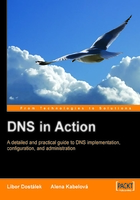
1.2 Name Syntax
Names are listed in a dot notation (for example, abc.head.company.com). Names have the following general syntax:
string.string.string ………string.
where the first string is a computer name, followed by the name of the lowest inserted domain, then the name of a higher domain, and so on. For unambiguousness, a dot expressing the root domain is also listed at the end.
The entire name can have a maximum of 255 characters. An individual string can have a maximum of 63 characters. The string can consist of letters, numbers, and hyphens. A hyphen cannot be at the beginning or at the end of a string. There are also extensions specifying a richer repertoire of characters that can be used to create names. However, we usually avoid these additional characters because they are not supported by all applications.
Both lower and upper case letters can be used, but this is not so easy. From the point of view of saving and processing in the DNS database, lower and upper case letters are not differentiated. In other words, the name newyork.com will be saved in the same place in a DNS database as NewYork.com or NEWYORK.com. Therefore, when translating a name to an IP address, it does not matter whether the user enters upper or lower case letters. However, the name is saved in the database in upper and lower case letters; so if NewYork.com was saved in the database, then during a query, the database will return "NewYork.com.". The final dot is part of the name.
In some cases, the part of the name on the right can be omitted. We can almost always leave out the last part of the domain name in application programs. In databases describing domains the situation is more complicated:
- It is almost always possible to omit the last dot.
- It is usually possible to omit the end of the name, which is identical to the name of the domain, on computers inside the domain. For example, inside the
company.comdomain it is possible to just writecomputer.abcinstead ofcomputer.abc.company.com. (However, you cannot write a dot at the end!) The domains that the computer belongs to are directly defined by thedomainandsearchcommands in the resolver configuration file. There can be several domains of this kind defined (see Section 1.9).